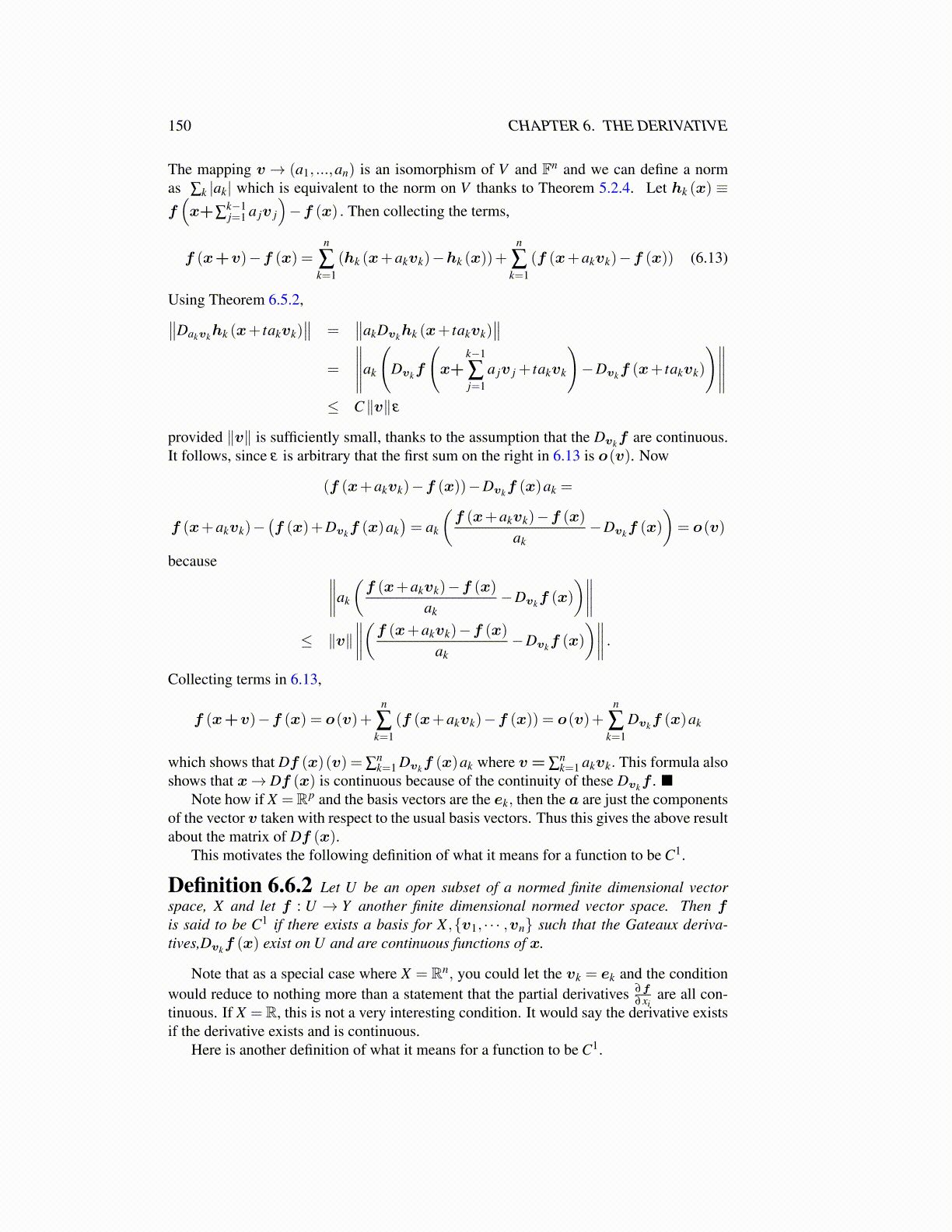
150 CHAPTER 6. THE DERIVATIVE
The mapping v → (a1, ...,an) is an isomorphism of V and Fn and we can define a normas ∑k |ak| which is equivalent to the norm on V thanks to Theorem 5.2.4. Let hk (x) ≡f(x+∑
k−1j=1 a jv j
)−f (x) . Then collecting the terms,
f (x+v)−f (x) =n
∑k=1
(hk (x+akvk)−hk (x))+n
∑k=1
(f (x+akvk)−f (x)) (6.13)
Using Theorem 6.5.2,∥∥Dakvkhk (x+ takvk)∥∥ =
∥∥akDvkhk (x+ takvk)∥∥
=
∥∥∥∥∥ak
(Dvkf
(x+
k−1
∑j=1
a jv j + takvk
)−Dvkf (x+ takvk)
)∥∥∥∥∥≤ C∥v∥ε
provided ∥v∥ is sufficiently small, thanks to the assumption that the Dvkf are continuous.It follows, since ε is arbitrary that the first sum on the right in 6.13 is o(v). Now
(f (x+akvk)−f (x))−Dvkf (x)ak =
f (x+akvk)−(f (x)+Dvkf (x)ak
)= ak
(f (x+akvk)−f (x)
ak−Dvkf (x)
)= o(v)
because ∥∥∥∥ak
(f (x+akvk)−f (x)
ak−Dvkf (x)
)∥∥∥∥≤ ∥v∥
∥∥∥∥(f (x+akvk)−f (x)
ak−Dvkf (x)
)∥∥∥∥ .Collecting terms in 6.13,
f (x+v)−f (x) = o(v)+n
∑k=1
(f (x+akvk)−f (x)) = o(v)+n
∑k=1
Dvkf (x)ak
which shows that Df (x)(v) = ∑nk=1 Dvkf (x)ak where v = ∑
nk=1 akvk. This formula also
shows that x→ Df (x) is continuous because of the continuity of these Dvkf . ■Note how if X =Rp and the basis vectors are the ek, then the a are just the components
of the vector v taken with respect to the usual basis vectors. Thus this gives the above resultabout the matrix of Df (x).
This motivates the following definition of what it means for a function to be C1.
Definition 6.6.2 Let U be an open subset of a normed finite dimensional vectorspace, X and let f : U → Y another finite dimensional normed vector space. Then fis said to be C1 if there exists a basis for X ,{v1, · · · ,vn} such that the Gateaux deriva-tives,Dvkf (x) exist on U and are continuous functions of x.
Note that as a special case where X = Rn, you could let the vk = ek and the conditionwould reduce to nothing more than a statement that the partial derivatives ∂f
∂xiare all con-
tinuous. If X =R, this is not a very interesting condition. It would say the derivative existsif the derivative exists and is continuous.
Here is another definition of what it means for a function to be C1.